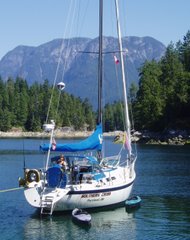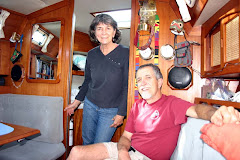 I was feeling pretty beat from lack of sleep, so we put into Farerea Pass on the seldom-visited east side of Huahine. After looking in vain for the perfect place to drop the hook, we settled for a sandbar just inside the pass, and decided we would continue around the north end of the island after a snooze. The last 10 miles to Avamoa Pass and the main town of Fare was a delightful sail with sun and calm seas.
I was feeling pretty beat from lack of sleep, so we put into Farerea Pass on the seldom-visited east side of Huahine. After looking in vain for the perfect place to drop the hook, we settled for a sandbar just inside the pass, and decided we would continue around the north end of the island after a snooze. The last 10 miles to Avamoa Pass and the main town of Fare was a delightful sail with sun and calm seas.
 Once inside the pass, we were soon settled at anchor off a postcard-perfect beach. The boat right behind us turned out to be the French boat "Xe," whom we met in the Marquesas last year. We enjoyed a swim, a short walk to the sleepy town of Fare, and an unexpected encounter with the crew of another boat that we had seen in the distance during the passage. We found that they hadn't enjoyed their first night passage of the season any more than we had! Amihai and Orly are an Israeli couple on a Lagoon catamaran named "Shibolet." You don't meet too many Israeli cruisers, so we told them about the other Israeli cat we had encountered last year in the Tuamotus with two men aboard. Turns out it was the same boat. Amihai had done the Puddle Jump with his cousin, and Orly had flown in to meet him in Papeete. They had a nasty encounter with some pit bulls while ashore on Tahiti, leaving them with severe bite wounds which soon became infected. They ended up flying home for treatment, and leaving the boat in Papeete for the season.
Once inside the pass, we were soon settled at anchor off a postcard-perfect beach. The boat right behind us turned out to be the French boat "Xe," whom we met in the Marquesas last year. We enjoyed a swim, a short walk to the sleepy town of Fare, and an unexpected encounter with the crew of another boat that we had seen in the distance during the passage. We found that they hadn't enjoyed their first night passage of the season any more than we had! Amihai and Orly are an Israeli couple on a Lagoon catamaran named "Shibolet." You don't meet too many Israeli cruisers, so we told them about the other Israeli cat we had encountered last year in the Tuamotus with two men aboard. Turns out it was the same boat. Amihai had done the Puddle Jump with his cousin, and Orly had flown in to meet him in Papeete. They had a nasty encounter with some pit bulls while ashore on Tahiti, leaving them with severe bite wounds which soon became infected. They ended up flying home for treatment, and leaving the boat in Papeete for the season.Our second day in Huahine has been a delight. There is good swimming from the boat, a nice beach ashore, lots of quiet paths for walking, and a wide choice of cheap eats in the village. Today we bought a fresh coconut for drinking and later eating, some spring rolls, and a coconut confection unlike any we had yet tried, all of which set us back $4. Cathy was given a large canteloupe from someone who had given her a ride back from a long walk she had taken. Amihai and Orly tried to buy us some fresh fish, but it was sold out by the time they got to the stall. We invited them over for bananas, coconut, and pineapple, and sent them home with fresh pamplemousse.
 Then they invited us to their boat for happy hour. Orly had little Israeli flags planted in the appetizers - nice! So fun to make new friends, too bad they are leaving in the morning for Raiatea. We plan to spend at least 2 weeks here on Huahine.
Then they invited us to their boat for happy hour. Orly had little Israeli flags planted in the appetizers - nice! So fun to make new friends, too bad they are leaving in the morning for Raiatea. We plan to spend at least 2 weeks here on Huahine.




















 The rear wheels were removed, and the trailer sides were slid back under the cradle.
The rear wheels were removed, and the trailer sides were slid back under the cradle.
 All the extra supports were cut away, and the trailer and cradle were bolted together. Then the whole thing was jacked up so the rear wheels coulod be reattached. At this point it was time for us to get off the boat.
All the extra supports were cut away, and the trailer and cradle were bolted together. Then the whole thing was jacked up so the rear wheels coulod be reattached. At this point it was time for us to get off the boat.

 The trailer was pulled out into the driveway, then backed through the yard toward the slipway ramp.
The trailer was pulled out into the driveway, then backed through the yard toward the slipway ramp.

 Once the trailer started down the ramp, the tractor was chained to a strong point.
Once the trailer started down the ramp, the tractor was chained to a strong point.
 Then the trailer was disconnected from the tractor, and allowed to slowly back down into the water, by means of a cable attached to a winch.
Then the trailer was disconnected from the tractor, and allowed to slowly back down into the water, by means of a cable attached to a winch.
 Once the boat was partway in the water, Yvan (boatyard manager) removed the last supports ahead and behind the keel, and climbed aboard the boat for the last part of the descent.
Once the boat was partway in the water, Yvan (boatyard manager) removed the last supports ahead and behind the keel, and climbed aboard the boat for the last part of the descent.
 Once the boat was afloat, I climbed aboard and checked through hulls, and the shaftlog for leaks. Once the trailer was removed, and the boat was secured to the slipway, I started the engine, checked the windlass, depth sounder, and other systems needed for maneuvering. We'll stay alongside the slipway tonight, as its easier to provision the boat from here.
It feels great to have the boat back in the water in such a beautiful place. We look forward to spending some time with Rupert and Judy on Khaya, one of the few other non-French boats that spent the hurricane season laid up here.
Once the boat was afloat, I climbed aboard and checked through hulls, and the shaftlog for leaks. Once the trailer was removed, and the boat was secured to the slipway, I started the engine, checked the windlass, depth sounder, and other systems needed for maneuvering. We'll stay alongside the slipway tonight, as its easier to provision the boat from here.
It feels great to have the boat back in the water in such a beautiful place. We look forward to spending some time with Rupert and Judy on Khaya, one of the few other non-French boats that spent the hurricane season laid up here.



